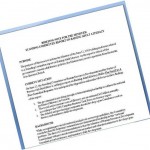How To Write Briefing Notes
THE PURPOSE
This purpose of this note is to present public sector writing practices for briefing notes. The focus is on both style and context. Although style and technique are important when writing for public sector audiences, it is an appreciation of the context that will distinguish you as a writer of superior briefing notes. Links to all examples are provided at the bottom of the page.
THE CONTEXT
Write as though you were a Minister receiving the briefing note (even if the note is for your Director or Deputy Minister). What would you need and want to know? Approach the task strategically, with political acumen. Yes, I know the Minister has political staff, but if you want to be a superior writer you must be sensitive to the political context.
Assume your first draft will be too long, verbose and bureaucratic. Avoid all three by rigorously & ruthlessly editing & revising. Ask yourself these questions to help you prepare superior briefing notes:
- Why has this note been requested? Why is the Minister dealing with this now?
- Given the purpose, context and scenario, what exactly does the Minister really need to know? What is the strategy, the game plan here?
- Have I identified the various actors or issues or options; outlined the stated and unstated agendas; and captured the strategic considerations?
- What is the bottom line? Have I identified or positioned “the goods” right up front in the note?
- Where are the pitfalls for the Minister? What is missing? What else is missing? Who else should I be talking to, obtaining intelligence from, consulting with?
- Would I be confident walking into this event/meeting with this note as my script?
- Is the level of detail I am providing appropriate to the subject and situation at this time? Is every word and paragraph essential? What can I edit out?
THE STYLE & STRUCTURE
There are various types of briefing notes, depending upon the purpose of the communication. Some are for information only, others provide recommendations and seek decisions. Cabinet briefing notes on other government departments (OGD) items provide information and proposed courses of action. The main sections or elements of briefing notes will vary depending on the purpose and type of note being written.
The Opening: Notes generally begin with either a Purpose Section or an Issues Section.
- Purpose Section: Begin the note with a clear statement identifying the purpose of the note. Why is the Minister reading this? This is a preferred approach, particularly if you are presenting options and a recommendation because you will alert the reader right up front that this is a “decision” note.
- Issue Section: Or, you can just begin the note with a clear and concise statement of the issue. This is a common format if, for example, the note will go into a briefing book along with other notes for a meeting or event where the purpose is defined somewhere else in the briefing book (like in a Scenario briefing note). It is not good form to use the Issue format if presenting options and a recommendation; instead, begin with the Purpose section.
The Body: The format will depend upon the content. It may include any combination of Background, Current Situation, Key Considerations, Conclusions, etc.
- The Background section begins with the most recent developments (rather than a chronological ordering of events culminating in the issue of the day). The purpose is not so much to provide a chronology of events but to identify and frame issues and problems.
- Discussion or Key Considerations are an outline of the variables to be taken into consideration regarding the issue. The various “sides of the story” are presented.
- Conclusions or Next Steps are “softer” than Recommendations. They represent the writer’s opinion or a conclusion that flows from the preceding sections, without necessarily presenting a comprehensive or balanced case. Key Considerations and Conclusions or Next Steps are often used as a “softer” way of presenting choices and recommendations.
Options and Recommendations are a more formal, balanced and objective presentation of the choices and preferred course of action. If the note provides Recommendations, they should be preceded by an Options section outlining the costs and benefits (pros and cons) of each option (one or more of which will be the recommendation). There may also be a Background and/or Current Situation section; however, there will not be Key Considerations or Conclusions as they would be redundant.
Speaking Points are often included in briefing notes (particularly ones for a meeting or event). They are written in simple, direct, punchy language; in bullet form to prompt speaking (rather than a text or a “speech”).
EXAMPLES OF BRIEFING NOTES
Click on the individual links to view, download or print the pdf format example of an Options & Recommendation Briefing Note for the Deputy Minister or an Information Briefing Note for the Minister.
The document you are currently reading is also available in pdf format. Click on the link to access the pdf on How to Write Briefing Notes.
_______________________________________________________________________________
We conduct public sector writing training; offer performance & professional development coaching; and review briefing, cabinet, parliamentary affairs, correspondence and other services for government departments.
_______________________________________________________________________________

